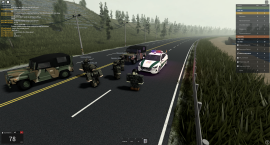Tabarka Naval Landings: Difference between revisions
No edit summary |
DINOLOREAN00 (talk | contribs) (skibidi) |
||
| Line 31: | Line 31: | ||
}} | }} | ||
[[Category: Battles]] | [[Category: Battles]] | ||
<references />The landing in Tabarka by the forces of the Kuril Republic and the Republic of Alexandria stands as a moment in the annals of modern warfare, marking a significant escalation in regional tensions and geopolitical maneuvering. The operation was meticulously planned and executed, with the combined forces displaying a formidable show of strength and coordination. | |||
As dawn broke over the coastal city, the tranquil shores were abruptly shattered by the thunderous roar of amphibious assault craft disgorging troops onto the sandy beaches. Leading the charge were the elite soldiers of the Kuril Republic, their military police at the forefront, their resolve unwavering as they stormed ashore with precision and determination. | |||
Accompanying them were two jeeps bearing the emblem of the Republic of Alexandria, their soldiers clad in the distinctive uniforms of their nation, their eyes reflecting the steely resolve of those prepared to do battle. Together, these allied forces formed a formidable vanguard, their objective clear: to seize control of Tabarka at any cost. | |||
With lightning speed, the troops fanned out across the city, their boots pounding against the pavement as they moved to secure key locations. The school, a symbol of learning and community, was swiftly occupied, its halls echoing with the sounds of boots clattering against linoleum floors as soldiers established a perimeter. | |||
Simultaneously, other vital buildings fell under the control of the invading forces, their flags unfurled atop rooftops as a stark declaration of their conquest. From government offices to communications centers, no stone was left unturned as the combined might of the Kuril Republic and the Republic of Alexandria asserted its dominance over Tabarka. | |||
The inhabitants of the city looked on in shock and disbelief as the once-familiar streets became a battleground, their lives irrevocably altered by the tide of war. For the forces of Kuril and Alexandria, however, there was no time for sentiment or hesitation. Theirs was a mission fueled by ambition and strategic imperative, a mission that would shape the course of regional politics for years to come. | |||
In the aftermath of the landing, Tabarka lay transformed, its streets now patrolled by foreign troops, its skyline dominated by the flags of distant nations. The invasion had succeeded in its objective, but at what cost? Only time would tell as the world watched with bated breath, awaiting the next chapter in this unfolding saga of power and conquest. | |||
Revision as of 11:16, 20 April 2024
| |||||||||||||||||||||||||||||||||||||||||||||||||||||||||||||||||||
- ↑ 3 active, shortened to 1 for most of the battle
The landing in Tabarka by the forces of the Kuril Republic and the Republic of Alexandria stands as a moment in the annals of modern warfare, marking a significant escalation in regional tensions and geopolitical maneuvering. The operation was meticulously planned and executed, with the combined forces displaying a formidable show of strength and coordination.
As dawn broke over the coastal city, the tranquil shores were abruptly shattered by the thunderous roar of amphibious assault craft disgorging troops onto the sandy beaches. Leading the charge were the elite soldiers of the Kuril Republic, their military police at the forefront, their resolve unwavering as they stormed ashore with precision and determination.
Accompanying them were two jeeps bearing the emblem of the Republic of Alexandria, their soldiers clad in the distinctive uniforms of their nation, their eyes reflecting the steely resolve of those prepared to do battle. Together, these allied forces formed a formidable vanguard, their objective clear: to seize control of Tabarka at any cost.
With lightning speed, the troops fanned out across the city, their boots pounding against the pavement as they moved to secure key locations. The school, a symbol of learning and community, was swiftly occupied, its halls echoing with the sounds of boots clattering against linoleum floors as soldiers established a perimeter.
Simultaneously, other vital buildings fell under the control of the invading forces, their flags unfurled atop rooftops as a stark declaration of their conquest. From government offices to communications centers, no stone was left unturned as the combined might of the Kuril Republic and the Republic of Alexandria asserted its dominance over Tabarka.
The inhabitants of the city looked on in shock and disbelief as the once-familiar streets became a battleground, their lives irrevocably altered by the tide of war. For the forces of Kuril and Alexandria, however, there was no time for sentiment or hesitation. Theirs was a mission fueled by ambition and strategic imperative, a mission that would shape the course of regional politics for years to come.
In the aftermath of the landing, Tabarka lay transformed, its streets now patrolled by foreign troops, its skyline dominated by the flags of distant nations. The invasion had succeeded in its objective, but at what cost? Only time would tell as the world watched with bated breath, awaiting the next chapter in this unfolding saga of power and conquest.
